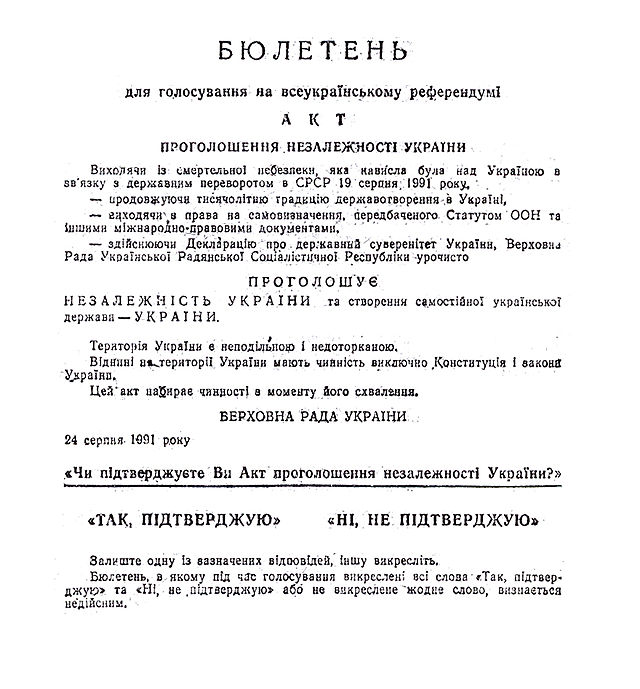Top Qs
Timeline
Chat
Perspective
1991 Ukrainian independence referendum
From Wikipedia, the free encyclopedia
Remove ads
A referendum on the Act of Declaration of Independence was held in Ukraine on 1 December 1991.[1] An overwhelming majority of 92% of voters approved the declaration of independence made by the Verkhovna Rada on 24 August 1991. The public vote was held in response to the failed August coup and the New Union Treaty not being signed.
Voters were asked "Do you confirm the Act of Declaration of Independence of Ukraine?"[2] The text of the Declaration was included as a preamble to the question. The referendum was called by the Parliament of Ukraine to confirm the Act of Independence, which was adopted by the Parliament on 24 August 1991.[3] Citizens of Ukraine expressed overwhelming support for independence. In the referendum, 31,891,742 registered voters (or 84.18% of the electorate) took part, and among them 28,804,071 (or 92.3%) voted "Yes".[2] On the same day, a presidential election took place. In the month up to the presidential election, all six candidates campaigned across Ukraine in favour of independence from the Soviet Union, and a "Yes" vote in the referendum. Leonid Kravchuk, the parliament chairman and de facto head of state, was elected to serve as the first President of Ukraine.[4]
From 2 December 1991 onwards, Ukraine was globally recognized by other countries as an independent state.[5][6][7] Also on 2 December, the President of the Russian SFSR Boris Yeltsin recognized Ukraine as independent.[8][9][10][11] In a telegram of congratulations Soviet President Mikhail Gorbachev sent to Kravchuk soon after the referendum, Gorbachev included his hopes for close Ukrainian cooperation and understanding in "the formation of a union of sovereign states".[12]
Ukraine was the second-most powerful republic in the Soviet Union both economically and politically (behind Russia), and its secession ended any realistic chance of Gorbachev keeping the USSR together. By December 1991 all former Soviet Republics except the RSFSR[13] and the Kazakh SSR[13] had formally seceded from the Union.[14] A week after his election, Kravchuk joined with Yeltsin and Belarusian leader Stanislav Shushkevich in signing the Belavezha Accords, which declared that the Soviet Union had ceased to exist.[15] The USSR officially dissolved on 26 December.[16]
Remove ads
Results
Summarize
Perspective



Ukrainian media had converted en masse to the independence ideal.
Polls showed 63% support for the "Yes" campaign in September 1991; that grew to 77% in the first week of October 1991 and 88% by mid-November 1991.[17]
55% of the ethnic Russians in Ukraine voted for independence.[18]
By region
The Act of Independence was supported by a majority of participating voters in each of the 27 administrative regions of Ukraine: 24 oblasts, 1 autonomous republic, and 2 special municipalities (Kyiv City and Sevastopol City).[4] Voter turnout was lowest in Eastern and Southern Ukraine.[17] The six regions with the lowest percentage of "yes" votes were Kharkiv, Luhansk, Donetsk, and Odesa Oblasts, Crimea, and Sevastopol; all of those regions still had a majority of registered voters marking their ballots "yes", except for Crimea and Sevastopol.
Remove ads
Analysis
Summarize
Perspective
Some experts claim that the 1991 Ukrainian independence referendum was the most immediate event that led to the collapse of the Soviet Union. According to Brian D. Taylor, in the aftermath of the failed 1991 Soviet coup attempt, most of the Soviet republics adopted declarations of independence, the most important of which was that of Ukraine. By the end of September, eight republics had declared independence: Belarus, Moldova, Azerbaijan, Uzbekistan, Kyrgyzstan, Georgia, Tajikistan and Armenia. These declarations of independence were largely symbolic and did not mean withdrawal from the union. Negotiations on the union continued for several months, but in the end, in the 1991 Ukrainian independence referendum, more than 90 per cent of Ukrainians voted for independence. Almost all observers agreed that serious federal discussions were impossible without Ukraine's participation.[22] On 6 December, shortly after Ukraine's independence referendum, the Supreme Soviet of Ukraine adopted a new military oath pledging loyalty to Ukraine. On 13 December, Leonid Kravchuk proclaimed himself Supreme Commander of the Armed Forces of Ukraine and declared that the Ukrainian Armed Forces would be formed from Soviet troops stationed in Ukraine.[22]
According to Mark Kramer, Boris Yeltsin often expressed his willingness to accept the independence of the Baltic states and Georgia and Moldova, but wanted to preserve the Union. What deprived Yeltsin of this option was the surge of independence sentiment in Ukraine after the coup attempt. Following the successful independence referendum, Yeltsin's only way to preserve the Soviet Union would have been to use massive force against Ukraine. However, Yeltsin chose not to and instead recognised the dissolution of the Soviet Union,[23] and joined the Belovezha Accords and the Alma-Ata Protocol.[24]
According to Adrian Karatnycky, although Yeltsin thwarted the coup and brought down the Soviet Communist Party, it was Kravchuk and Ukraine that ultimately brought down the Soviet Union. Ukraine's rejection of Mikhail Gorbachev's Union Treaty led to the immediate collapse of the Soviet Union.[25]
According to Peter J. Potichnyj, Yeltsin and Gorbachev consistently sabotaged Ukraine's independence. However, because the referendum was conducted in an open and democratic manner, it convinced Russia and world leaders that the Soviet system was no longer viable or sustainable.[26]
According to Laura Blaj, the Ukrainian Communist Party rejected the Soviet reforms of Gorbachev and Yeltsin. This was a decisive factor in Ukraine's overwhelmingly positive vote. The Communist conservatives were allied with Ukrainian nationalists and the result of the Ukrainian referendum therefore led directly to the collapse of the Soviet Union.[27]
Remove ads
See also
References
External links
Wikiwand - on
Seamless Wikipedia browsing. On steroids.
Remove ads


